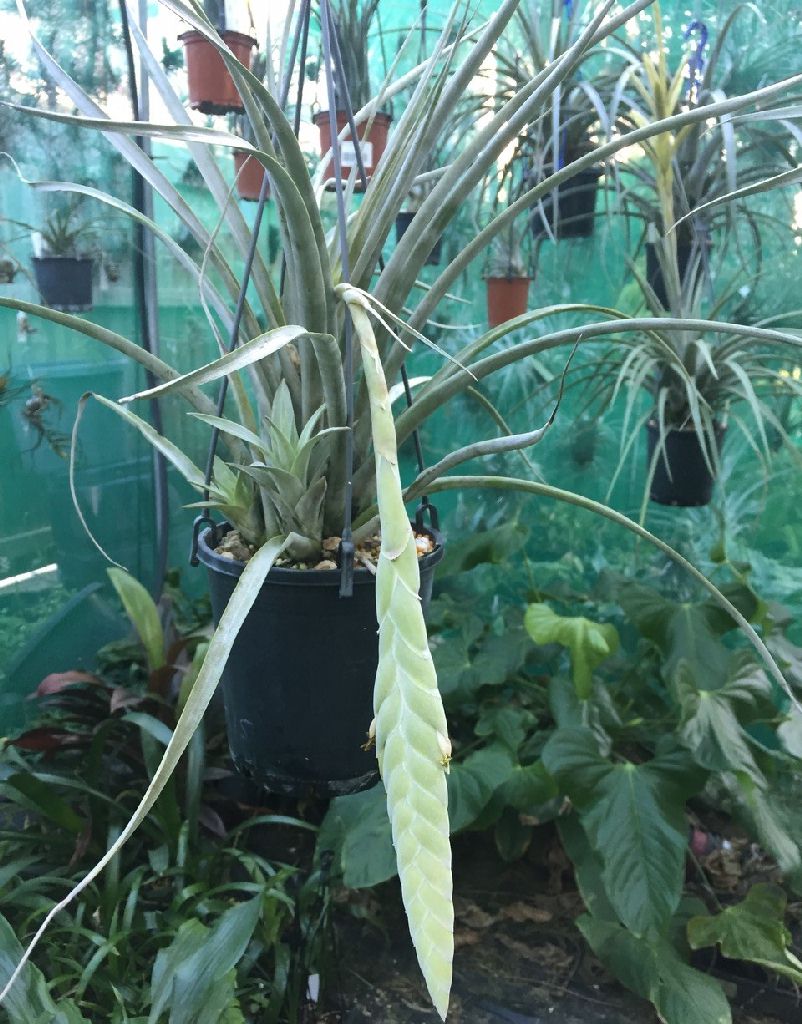
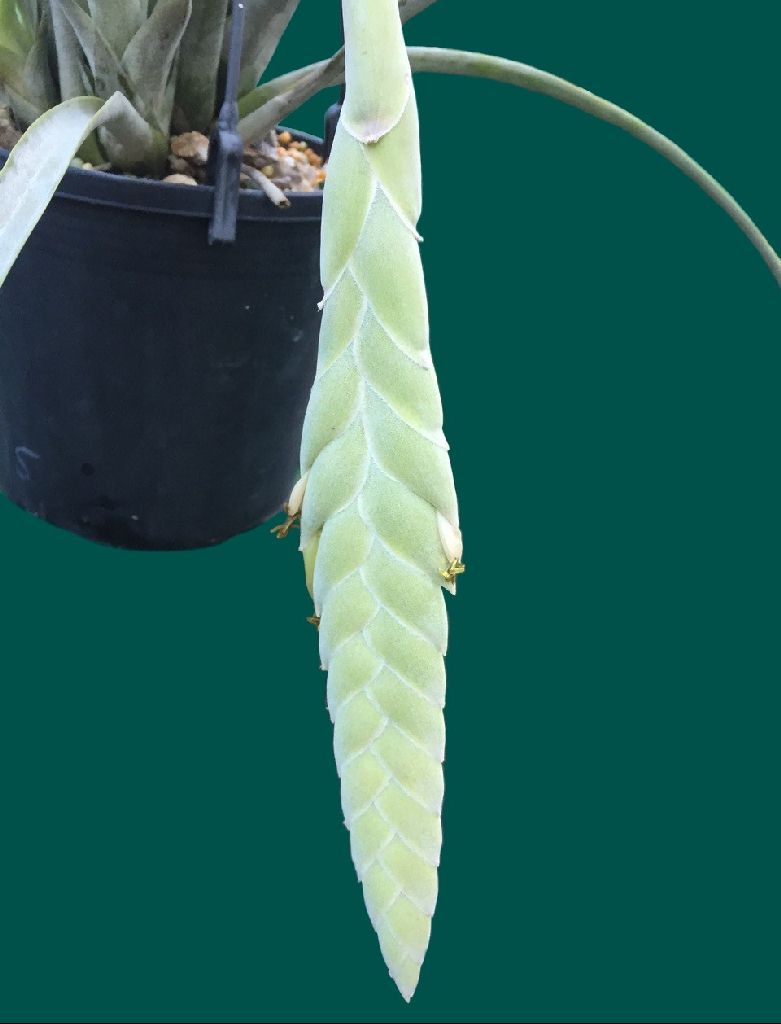
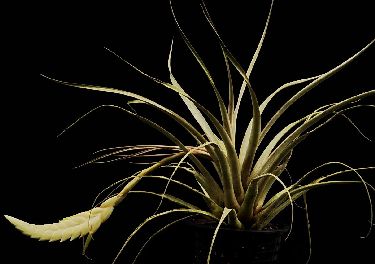
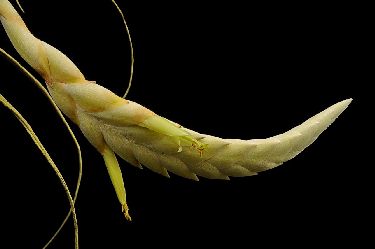
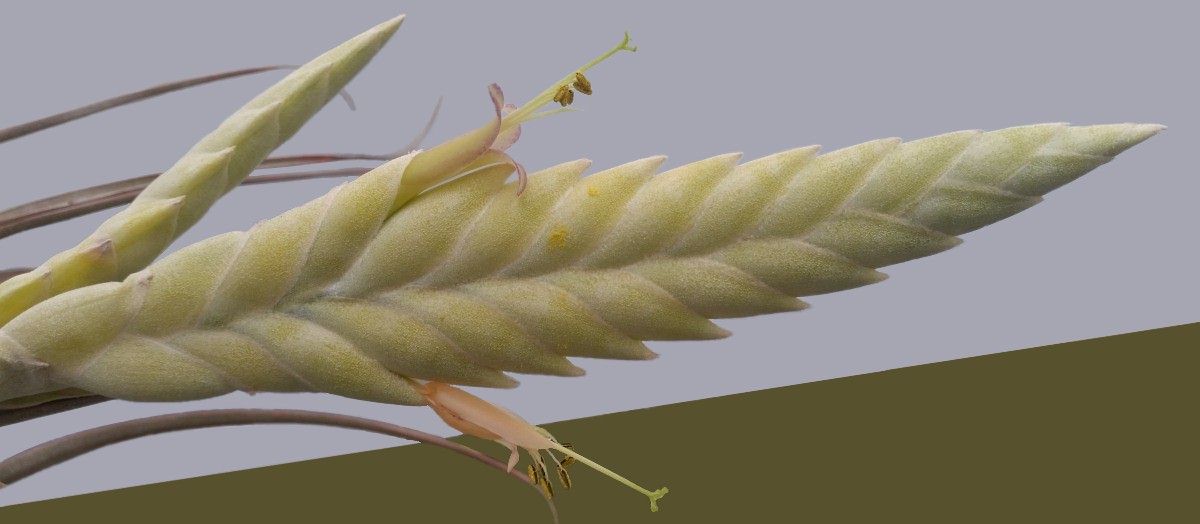
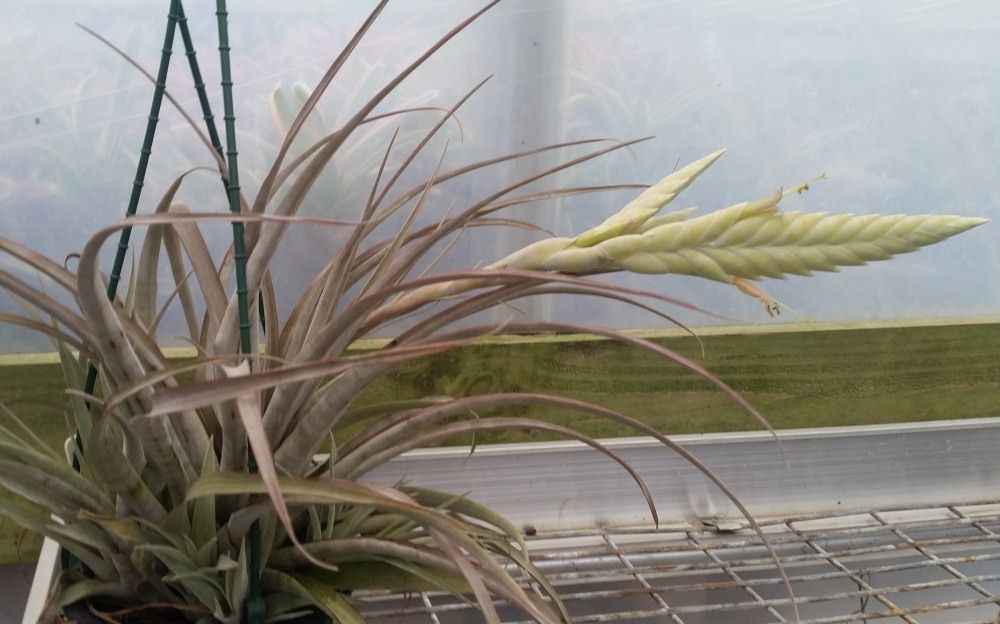
Tillandsia curvifolia (Ehlers & Rauh) Ehlers, stat. nov. Die Brom Sonderheft 6: 126-134. 2009
Type: Mexico, Estado Guanajuato, near Guanajuato, 2400 m s.m., 6.3.1985, R. & K Ehlers M850201 (holo WU).
Basionym: Tillandsia tortilis Klotzsch ex Baker subsp. curvifolia Ehlers & Rauh, J. Bromeliad Soc. 40:166, figs. 7,8 (1990).
Plant stemless or with short stem, flowering 5-15 cm high, few (8-12) spirally arranged, silvery-white scaled leaves forming an erect, secund rosette that is bent to one side.
Leaves 4-16 cm long,
sheaths 15 mm long, 12 mm wide, oval, somewhat succulent, with translucent margins, densely scaled, glabrous only at the base.
Blades clearly distinct from the sheaths, up to 14 cm long, 7 mm wide above the sheath, narrow-triangular, long acuminate, secund upwards, almost succulent, awl-like, canaliculate, the margins bent inwards and with asymmetrical trichomes, adaxially dense appressed scales, abaxially with spreading, eccentric, feltlike, white scales.
Inflorescence erect,
peduncle up to 5 cm long, 2 mm diameter, glabrous to weak scaled, covered with 3-5 dense erect, tile like (imbricate) peduncle bracts,
peduncle bracts 3-5 times longer than the internodes, lower ones similar to the leaves, with up to 7 cm long, awl-like acuminate blades, the upper ones similar to the floral bracts.
The fertile part of the inflorescence shorter or a little longer than the leaves, simple or very rarely with a smaller lateral spike, elliptic to narrow-elliptic, tipped, 2-3 cm long, up to 1 cm wide, terete, with (1-) 2-5 spirally to subspirally arranged flowers (usually 3 fertile flowers and 1 sterile bract at the base), the angulate, stout, densely scaled axis not visible.
Floral bracts erect, densely imbricate, 12 cm long, 1 cm wide, a little longer than the sepals, oval or lanceolate, acuminate, thin with transparent margins, adaxially green, glabrous, nerved, abaxially pink, densely scaled, weak, toward the tip clearly nerved, 2-3 times longer than the internodes.
Sepals up to 15 mm long, 4 mm wide, lanceolate-oblong, thin membranaceous, with translucent margins, free, the adaxial clearly carinate, glabrous to some scales near the apex.
Petals 5-7 mm longer than the floral bracts, 2-2,7 cm long, 4 mm wide, erect, tongue shaped with round tips that are clearly bent back, #80 nile green or #79citron (Isley III, P. T. 1987, colour chart), white at the base.
Stamens deeply enclosed in the flower, filaments up to 15 mm long, all equally long, flattened filiform, white, anthers 3-5 mm long, erect, arrow-shaped (sagittate), fixed at the base, light brown,
pollen pale yellow,
pistil l0 mm long, extending itself after the maturity of the anthers, whitish-green, green towards the tip,
stigma small, stigma lobes erect, somewhat spreading at anthesis.
Ovaries 4 mm long, 2 mm wide, whitish-green.
Seed capsule 24-25 mm long.
Flowering January-March
Species name - The species name refers to the curved leaves.
Habitat and Range - In the highlands of central Mexico this species mostly grows lithophytic, sporadicly epiphytic and in the majority of cases in large clumps.
Cultivation - Tillandsia curvifolia is a bit delicate in culture. In winter it should be kept not too moist, in summer it can be cultivated outside.
Tillandsia curvifolia differs from T. tortilis Klotzsch ex Baker by the following characteristics: Plant small, leaves neither extending nor bent back but erect and strongly secund, the leaf scales are more felt-like and more spreading. The peduncle is shorter, thicker and somewhat scaled, the inflorescence is roughly as long as the leaves or shorter, (not widely exceeding). The peduncle bracts are twice as long and have filiform acuminate blades. The inflorescence is smaller, with fewer flowers than Tillandsia tortilis and not strongly flattened but terete (round) with spirally arranged flowers. The rhachis is not almost straight and glabrous but bent and scaled. Flowers smaller, sepals not lepidote but nearly glabrous, more carinate, petals onley 2-2,7 cm long (not up to 3.8 cm,) and only 5-7 mm longer than the sepals, (with Tillandsia tortilis the petals are l0-15 mm longer). The tips of the petals are clearly bent back and brighter green, #8o nile green (instead of #82 moss green) after Isley III., P. T. 1987 (colour chart).
History: In 1979, when I first showed Professor Werner Rauh a flowering plant with spiralling flowers, and was in agreement with him, that this was not a small Tillandsia tortilis, but he could hardly believe that this was a truly consistent characteristic with wider occurrences. He told me, that he would agree to a description of the plant when he had seen 20 inflorescences, that all showed these qualities.
Many years would pass however before we visited Hidalgo again. Finally in 1985, Klaus and I drove to the location, in order to collect the 20 inflorescences as requested. Back at home, we visited Professor Rauh who was amazed that we could really submit precisely 20 inflorescences. Now he agreed that it was something new!
However my own opinion that it is an individual species, was not accepted. Also the fact that Eric Gouda from Utrecht found 20 deviant characteristics by means of a computer-analysis of both plants, could not change his opinion. The plant was merely described as Tillandsia tortilis Klotzsch ex Baker sub-spec. curvifolia Ehlers & Rauh, 1990, in the Journal of The Bromeliad Society: Vo1. 40, Nr. 4,166-168; 1990.
Nevertheless I was very proud, for this was my first description, in which my name was placed first.
In the meantime, I have discovered many other locations of this taxon in various states in the north of Mexico and they have been examined very thoroughly. Usually this species grows on rocks, however in the Sierra Morones we have also found it growing as an epiphyte.
We found a very deviant form on a trip in December 2000 with Lydia and Gerhard Kohres at the border between Durango and Zacatecas before San Luis Capistrano, that we were also able to collect on our trip with Jurgen and Uli Lautner and Manfred Kretz in February 2004. On steep rock-walls, a mini-form grows in dense, large groups. The individual plants are much smaller, usually only about half as large as the type form. The inflorescences are restricted only to 1-2 flowers and moreover the floral bracts, even in Mexico are light green and not pink coloured as at other locations in Mexico.
All examinations and studies have yielded that the differences between Tillandsia tortilis and T. curvifolia are so large, that treating them as separate species is justified. Tillandsia tortilis has many more flower characteristics in common with T. lepidosepala Smith than with T. curvifolia. Moreover, at some locations Tillandsia tortilis and T. curvifolia grow together without any hybridising being determined. At the type locality near Guanajuato, I could photograph and collect Tillandsia tortilis and T. curvifolia, only few centimetres apart, growing on the rock. Even in the non-flowering state, it is very easy to identify the plants. Moreover, if one sees the inflorescences however, then it becomes evident that they are two quite different species. Tillandsia curvifolia is the only member from this whole complex, does not show not strictly distichous flower spikes, rather the inflorescence has a few spirally arranged flowers.
After many years of study and observations, I would like to give the plant its proper status: Tillandsia curvifolia, (Ehlers & Rauh) Ehlers, stat. nov.
Examined material.
Zacatecas: Cerro de la Bufa, Febr. 2003, G. Noller s.n. (WU).
Guanajuato: Guanajuato-Dolores Hidalgo, epilithic, Marz 1979, K. & R. Ehlers 34 (WU); Guanajuato-Hidalgo, 2250 m, 25.3.1998, Ehlers EM982201 (WU); Guanajuato-Hidalgo, 2420 m, 18.2.2006, Ehlers EM061502 (WU); Guanajuato-Hidalgo, Febr. 2003, G. Noller s.n. (WU); San Felipe-Silao, 2420 m, 20.2.2006, epilithic, Ehlers EM061702 (WU); Llanos de la Fragua, 1650 m, 25.3.1998, epilithic, Ehlers EM061703 (WU); Guanajuato, San Juan de Llanos, epilithic, Ehlers EM982204 (WU);
Border Durango-Zacatecas, from San Luis Capistrano, 2460 m, 1.12.2000, Ehlers EM001403 (WU). l.c., 10.2.2004, Ehlers EM041702 (WU). l.c., Februar 1991, M. Kretz 491 (WU).
Aguascalientes: Sierra Morones, Tlaltenango-Jalpa, epiphytic, 20 3.1990, Ehlers EM902106 (WU); Jaltiche de Arriba, 3000 m, W Schindhelm s.n. (Foto).